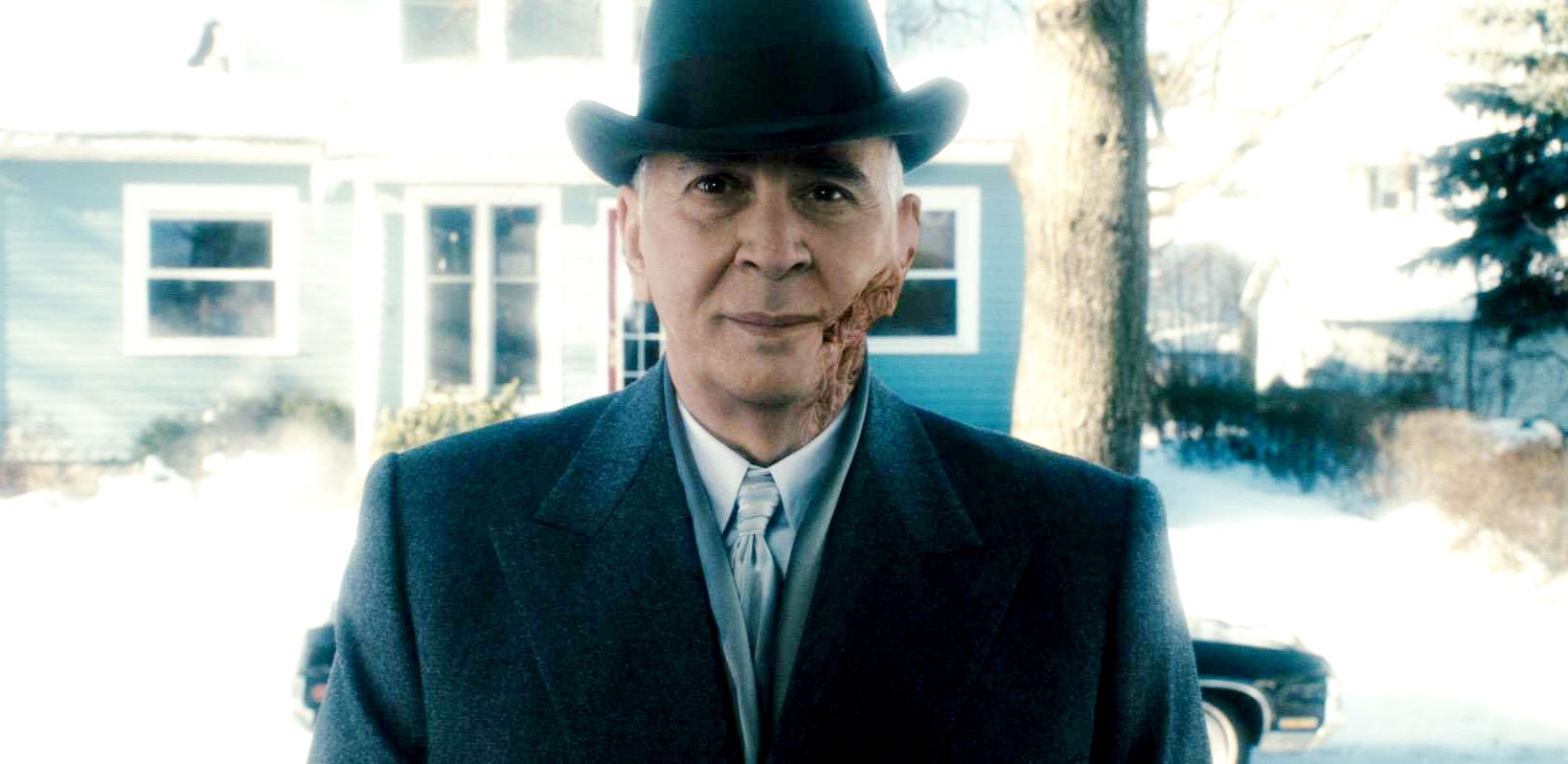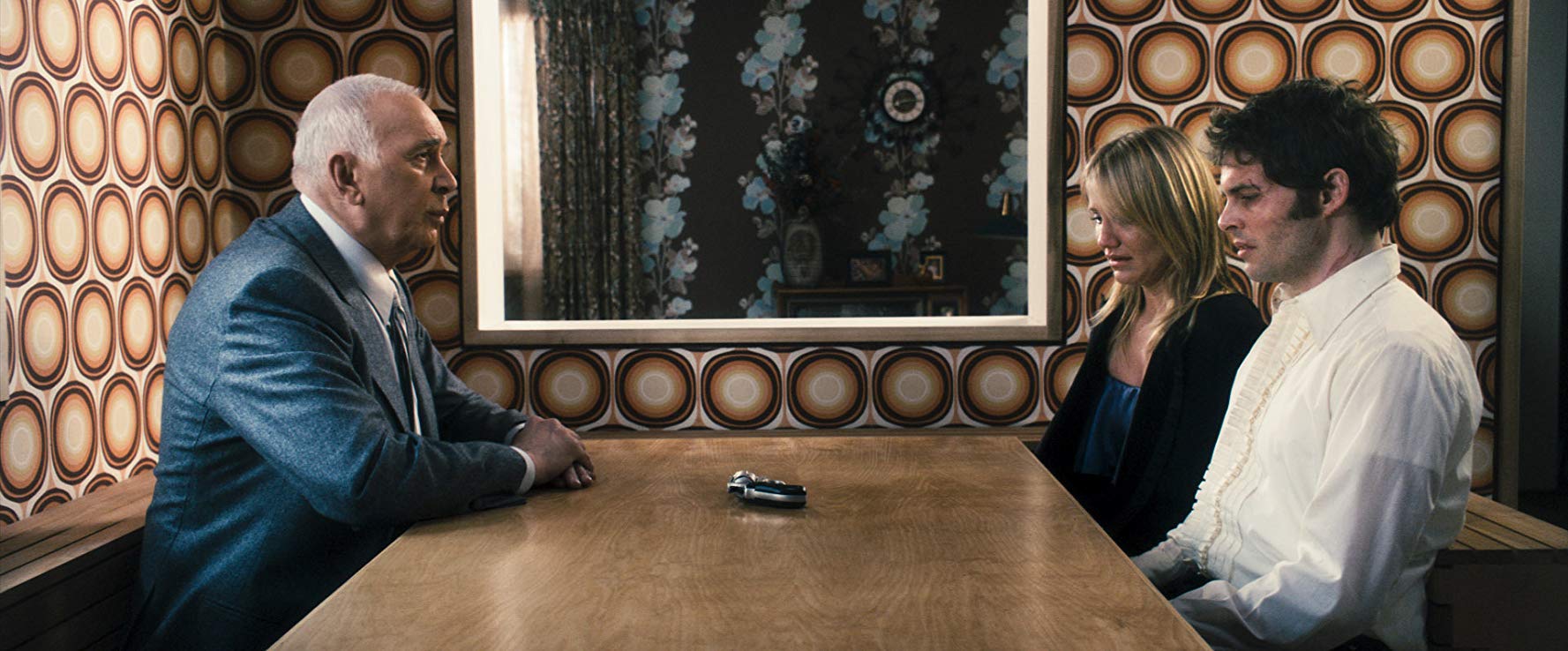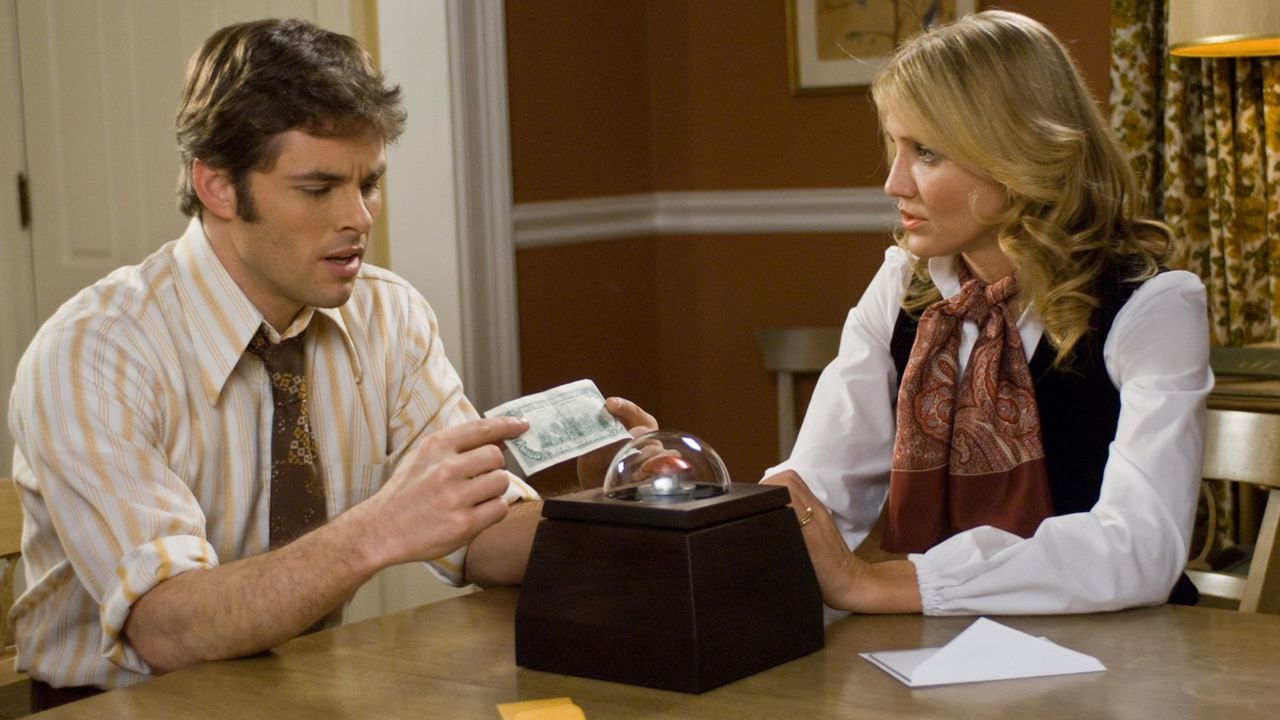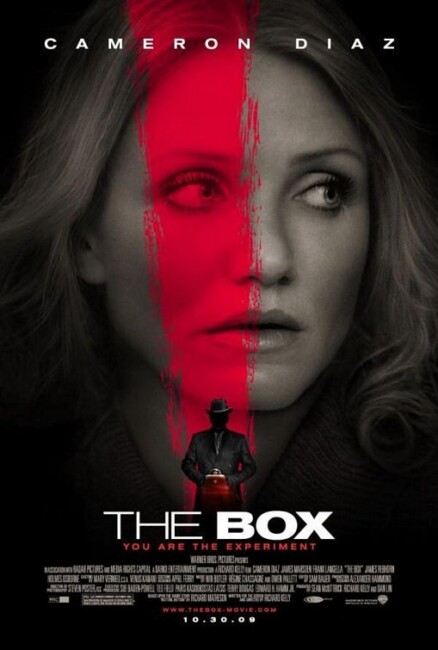USA. 2009.
Crew
Director/Screenplay – Richard Kelly, Based on the Short Story Button Button by Richard Matheson, Producers – Richard Kelly, Dan Lin, Kelly McKittrick & Sean McKittrick, Photography – Steven Poster, Music – Win Butler, Regine Chassagne & Owen Pallett, Music Supervisor – Chris Mollere, Visual Effects Supervisor – Thomas Tannenberger, Visual Effects – Gradient Effects LLC (Supervisor – Olsun Tan) & Pixel Liberation Front (Supervisor – Kent Seki), Special Effects Supervisor – Judson Bell, Production Design – Alexander Hammond. Production Company – Warner Brothers/Radar Pictures/Media Rights Capital/Darko Entertainment.
Cast
Cameron Diaz (Norma Lewis), James Marsden (Arthur Lewis), Frank Langella (Arlington Steward), Holmes Osborne (Dick Burns), James Rebhorn (Norm Cahill), Sam Oz Stone (Walter Lewis), Gillian Jacobs (Dana), Celia Weston (Lana Burns), Deborah Rush (Clymene Steward), Mark Cartier (Martin Teague), John Magaro (Charles), Lisa K. Wyatt (Rhonda Martin), Ryan Woodle (Jeffrey Carnes)
Plot
Richmond, Virginia, 1976. Husband and wife Arthur and Norma Lewis are puzzled one morning to find that a mysterious box has been left on their doorstep. The box contains a red button underneath a locked plastic cover and a note saying that Mr Steward will visit them at 5 pm. During the course of that day, Norma is told that the faculty where she teaches will no longer cover her tuition, while Arthur receives notice at the NASA laboratory where he works that he has been rejected for consideration for the space shuttle program. That evening, Norma meets Arlington Steward. He gives her the key to the box and tells her that if they decide to push the button this will kill somebody that they do not know but they will receive one million dollars. The stipulations are that they are not to ask about Steward’s employers or to tell anybody else. After much debate about whether this is a hoax, Norma decides on impulse to push the button. Mr Steward duly arrives and gives them the one million dollars. Subsequently, Arthur starts to ask questions and tries to have the licence plate on Steward’s car traced. Soon after, sinister things begin to happen, including people following them and behaving strangely. Arthur finds that Steward used to work for NASA but was hit by lightning and killed on the day of the Viking 1 landing on Mars. Claiming to be under the direction of the forces that sent the lightning, Steward has the ability to mentally control others. On behalf of his ’employers’, he is engaged in an elaborate experiment to test humanity using the box.
A few years ago, director Richard Kelly seemed to be shaping up as a name with an interesting buzz attached to it. Richard Kelly’s directorial debut was Donnie Darko (2001), which became an instant cult hit. I must admit that I was never part of the Donnie Darko cult and found Kelly’s enigmatic mystery and lack of solutions frustrating as opposed to profound. Subsequently, Kelly went onto write the script for Tony Scott’s demented true-life bounty hunter biopic Domino (2005) and then directed/wrote the troubled SF film Southland Tales (2006), which was given a less-than-enthusiastic response but is a work of some interest. Richard Kelly also wrote the script for Tony Scott’s Domino (2005), a biopic of bounty hunter Domino Harvey that goes lunatically out-of-control with highly entertaining results. Kelly’s company Darko Entertainment has also produced a handful of films, including I Hope They Serve Beer in Hell (2009), God Bless America (2011), Bad Words (2013), Hell Baby (2013) and Happy Birthday! (2016).
The Box was Richard Kelly’s third film and the last he has directed to date. It was a project that Kelly has touted for several years – since at least 2003, where it was at one point to be directed by Eli Roth of Hostel (2005) fame. The Box is based on the short story Button Button (1970) by genre legend Richard Matheson, the novelist and screenwriter responsible for a number of classic works including The Incredible Shrinking Man (1957), Roger Corman’s Edgar Allan Poe films, Duel (1971), The Night Stalker (1972), the novel version of I Am Legend (1954) and episodes of The Twilight Zone (1959-63) and Star Trek (1966-9). (See below for Richard Matheson’s other genre works).
The original story appeared in Playboy magazine. In the story, Norma and Arthur Lewis are a poor couple who receive a visit from Mr Steward and are given the box and an offer of money ($20,000 in the original) if they press the button that will kill one stranger whom they do not know. After much debate, Norma presses the button. The story radically differs from the film as to what happens then – in the story, it is Arthur that is killed, after which Mr Steward explains to Norma that she “never really knew who he was.”

Button Button was also adapted as an episode of the first season of the revived The Twilight Zone (1985-9) with Norma and Arthur played by Mare Winningham and Brad Davis and Mr Steward by Basil Hoffman (who makes a small cameo near the start here). The ending of the episode differs from the short story in that Mr Steward claims the box back but leaves them with the implication that it will be given to someone they do not know and that they will be that couple’s victims. Richard Matheson wrote the tv version but was unhappy with changes made to the ending and substituted a pseudonym on the finished script.
Several things become clear from examining the other versions of the story and comparing them to the finished film here. The most obvious one is that the story is a single act and nothing more than that – it hinges on the idea of a couple being offered a terrible choice. The set-up is like one of the soul-searching morality questions you get asked in a game of Scruples or Would You Rather – “would you be prepared to let someone you didn’t know die in return for a million dollars?” In none of these versions does Richard Matheson explain anything about who Mr Steward is or the agency behind the offer. Both versions also seem vague and arbitrary about what happens after the button is pushed – the drama of the story seems to be more about the question of whether to push the button or not than what happens after.
The problem with this set-up is that it is perfectly suited to a short story or half-hour tv episode with a sting ending rather than a feature film that requires the expanding of the idea out beyond the question of what happens after the button is pushed. This is given evidence by Richard Kelly’s press interviews where he discusses some of the previous versions of the script where he at one point had the box turning into a giant killer robot. In his finished script here, Kelly may well have been inspired by an earlier science-fiction film The 27th Day (1957) wherein five strangers from around the world are chosen by aliens and given boxes that will destroy large sectors of humanity if they choose to open them.
Richard Kelly sets up a fine first act. The period setting – which comes with the same slightly faded colour tone that Kelly said was inspired by David Fincher’s Zodiac (2007) – is flawless. Kelly gets all the period details right – the clothing and hairstyles, the banal interior decorations of the suburban homes, the tv shows in the background, photos of Gerald Ford as President, games of Monopoly. (The only quibble might be when Sam Oz Stone produces copies of the classic pulp magazine Astounding Science-Fiction but then describes it as a comic-book rather than a magazine that printed short stories). The performances and Richard Kelly’s direction is quiet and subdued, the proposition and Frank Langella’s appearance appropriately ominous, and the doubts and questions of morality and conscience over what to do about the box perfectly handled. The button is pushed … and then, well, The Box fragments off into directions that are frankly head-scratching.

Richard Kelly is one of modern cinema’s prime obscuritanists. His works remind of the books of novelist Tim Powers – The Anubis Gates (1983), On Stranger Tides (1988), The Stress of Her Regard (1990), Last Call (1993) – who always writes as though he had too many ideas and too little paper on which to put them all, resulting in a series of head-spinning (albeit brilliant) works that frequently leave you lost trying to keep up with the pace the author is whipping ideas by. A cinematic equivalent might be the ultra-cryptic Japanese horror director Kiyoshi Kurosawa – see films like Cure (1997), Pulse (2001), Retribution (2006) – whose works come with a baffling lack of explanation that feel akin to the narrative equivalent of M.C. Escher architecture – or maybe more so The Wachowski Brothers when they made The Matrix Reloaded (2003) and The Matrix Revolutions (2003) and followed the brilliance of The Matrix (1999) with two frustrating works of questions and half-answers that only muddied and confused the original. All of Richard Kelly’s films come with this exasperating sense of too many ideas and far too little done to make them gel together or even answer the questions raised. Certainly, those who celebrated Donnie Darko as a cult film have failed to stay with Richard Kelly through his subsequent films.
After getting past the essence of Richard Matheson’s original story, Kelly seems stuck about what to do. There was a reasonable time thereafter where it seemed like he was making something fascinating. He does a fine job of suggesting something increasingly sinister surrounding Cameron Diaz and James Marsden – people they are talking to constantly manifesting bloody noses or just turning and staring at them, John Magaro tauntingly mimicking pushing a button in the background at a party, babysitter Gillian Jacobs going into a trance and giving warnings before she returns to her motel and walks down a hallway sinisterly filled with people who all open their doors to stare at her and then ominously gather around the pool outside.
The two spookiest scenes that Kelly generates are one where Cameron Diaz is on the phone to Frank Langella and pleads with him to sit down and talk and he replies “I’m looking at you right now, Norma. I’m in your backyard” and then a mystery man peers in through the window and walks around the house. The other being where Cameron Diaz and James Marsden both separately end up at a library and the patrons, who all move together as one, follow them through the building.
During these scenes, Richard Kelly creates a palpable and threatening sense of something about to happen. Even up until well over the halfway point, The Box still seems like a film that is going in a number of interesting places. Alas, Kelly chooses to wrap it up in a way that plays into his preponderance for mystifying, non-sequitir endings rather than ones that makes any cohesive sense. [PLOT SPOILERS]. The explanation seems to involve a frankly baffling scenario concerning Frank Langella who was a NASA scientist and was hit by a lightning bolt at exactly the same time as the real-life Viking Lander touched down on Mars. Subsequently, he was revived from the dead and is now directed by “the people who control the lightning” (who are presumably of alien origin) and have given him the box to conduct an experiment to decide whether humanity is worthy of being allowed to continue or should be shut down. For reasons not made clear, the NSA and various government agencies seem to know what is going on and are complicit in this scheme. It is also not clear what the Viking Lander did to start this in motion.

[PLOT SPOILERS CONTINUE]. Frank Langella has also been granted the ability to possess others and see/speak through their bodies, which has a habit of causing nosebleeds. We are given an explanation of the box at the end where we see that people who activate it are then given the choice of allowing their children to live with their major senses permanently impaired or that the other party shoots the activator of the button and how this choice comes into being at exactly the same time as the next couple push the button (something that ties back in the explanation used in the Twilight Zone version of the story).
[PLOT SPOILERS CONTINUE]. Elsewhere though, Richard Kelly leaves plot points hanging in confusion. There is a big mysterious scene where James Marsden is directed through the library and offered three choices and told that one is the right choice but the other two lead to damnation. Three shimmering forcefields that seem to be made of water appear and he chooses one (although we are never told whether this is the right one or not) and this causes him to appear in an oblong prism of water above Cameron Diaz’s bed, which then collapses. Events continue but this scene and its ramifications are never referred to again.
[PLOT SPOILERS CONTINUE]. Similarly, after James Marsden drops babysitter Gillian Jacobs off at her motel, he takes her driver’s license and discovers that she is someone else altogether, while inside her room we see a map covering an entire wall with various pins and connecting threads all over it, giving the impression that she has been tracking the box’s activity. Who she is and why she is tracking this is never explained or referred to again. Several times we see the possessed gathering outside the motel swimming pool. They bring Sam Oz Stone there after abducting him where the waters of the pool start glowing and bubbling in extremely unnatural ways. What the significance of this is we never know either. It is this frustrating tendency of Richard Kelly to make his story resolutions as baffling and cryptic as possible that turns The Box from a strong set-up to one that bombed on delivery with audiences.
Richard Matheson’s other genre works include:- The Incredible Shrinking Man (1957) based on his own novel, Roger Corman’s Edgar Allan Poe adaptations The House of Usher/The Fall of the House of Usher (1960), Pit and the Pendulum (1961), Tales of Terror (1962) and The Raven (1963), the Jules Verne adaptation Master of the World (1961), the occult film Night of the Eagle/Burn, Witch, Burn (1961), the Corman-produced mortician’s comedy The Comedy of Terrors (1963), The Last Man on Earth (1964) based on his novel I Am Legend (1954) concerning a world taken over by vampires, the Hammer psycho-thriller The Fanatic/Die, Die, My Darling (1965), the classic Hammer occult film The Devil Rides Out/The Devil’s Bride (1968), the historical biopic De Sade (1969), Steven Spielberg’s first film Duel (1971), The Night Stalker (1972) and The Night Strangler (1973) tv movies, the haunted house film The Legend of Hell House (1973) from his novel, the tv adaptation of Dracula (1974), the tv movies Scream of the Wolf (1974), The Stranger Within (1974), Trilogy of Terror (1975), Dead of Night (1977) and The Strange Possession of Mrs. Oliver (1977), the tv adaptation of Ray Bradbury’s The Martian Chronicles (1980), the time travel romance Somewhere in Time (1980) from his own novel, Jaws 3-D (1983), Twilight Zone – The Movie (1983), and numerous classic episodes of The Twilight Zone, Thriller and Star Trek. Works based on his stories are The Omega Man (1971) from his I Am Legend, the afterlife fantasy What Dreams May Come (1998), the fine ghost story Stir of Echoes (1999), I Am Legend (2007) and Real Steel (2011).
Trailer here


